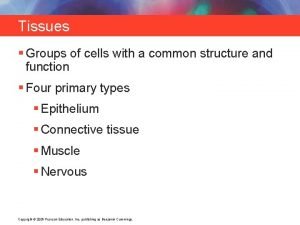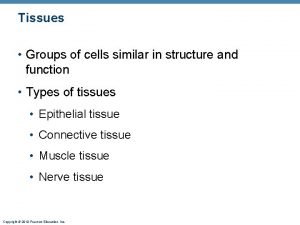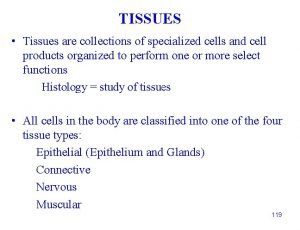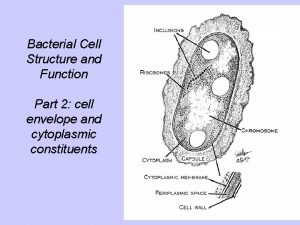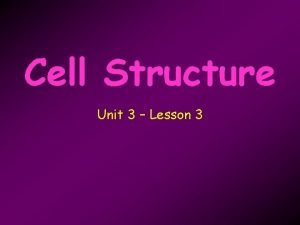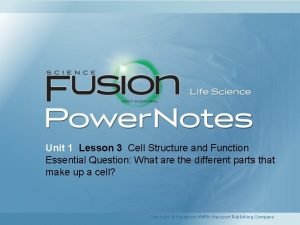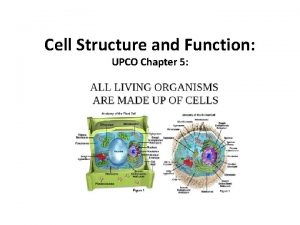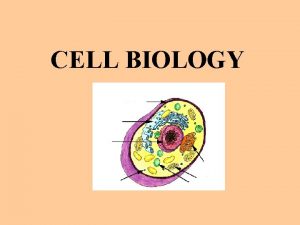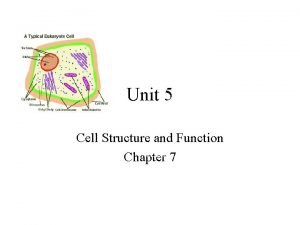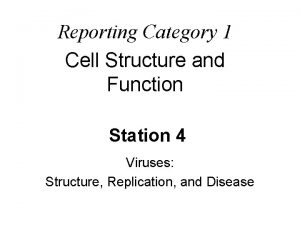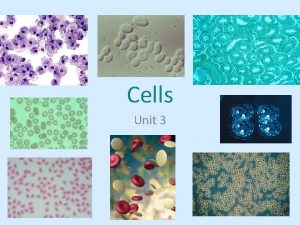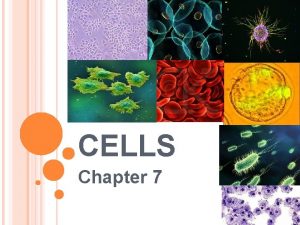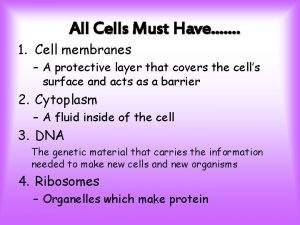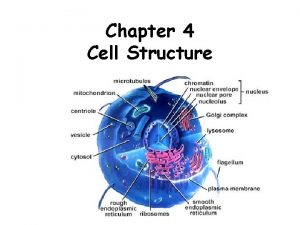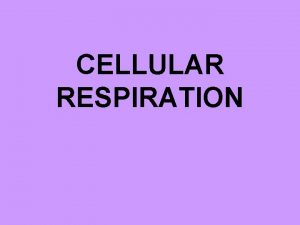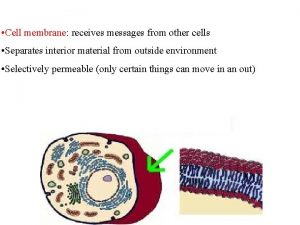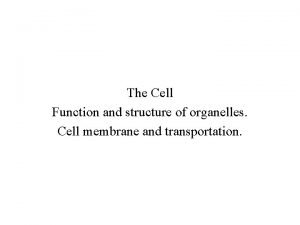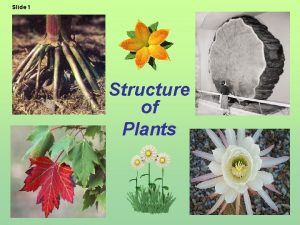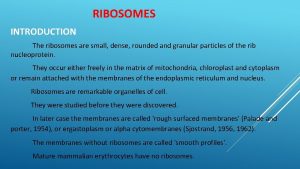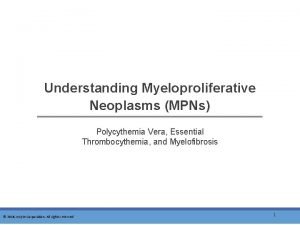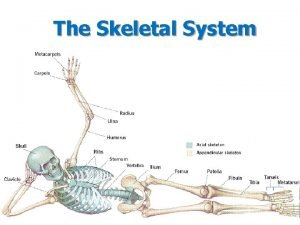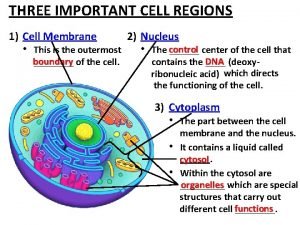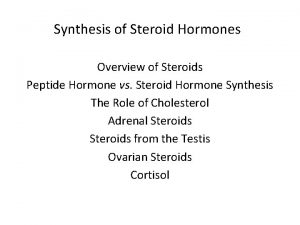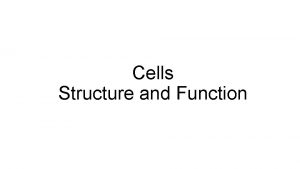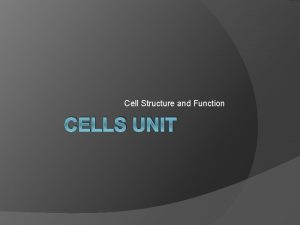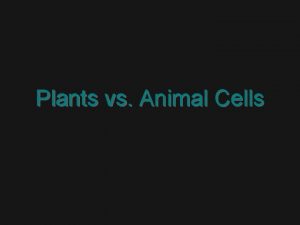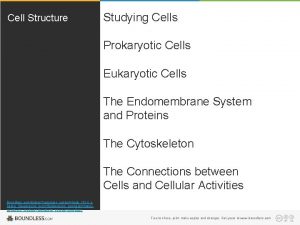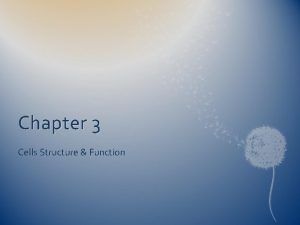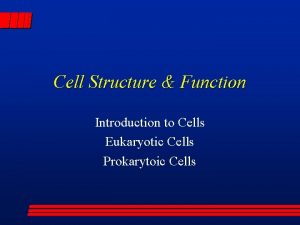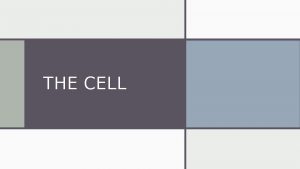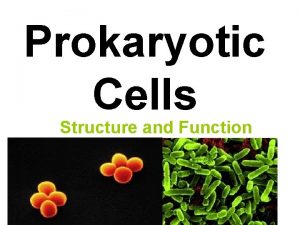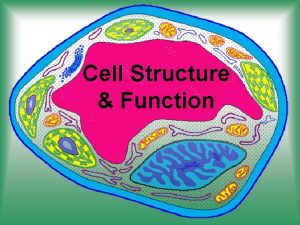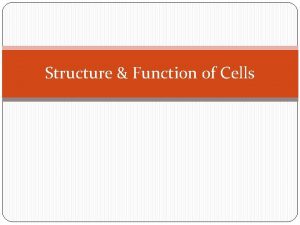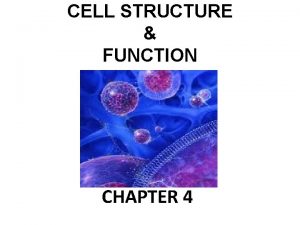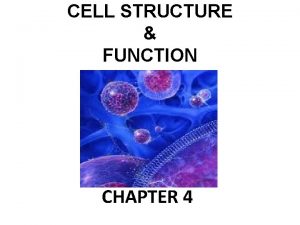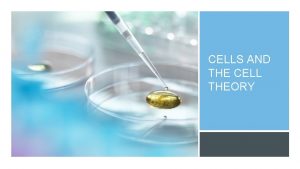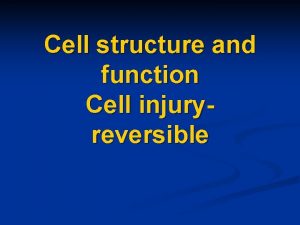Cell Structure and Function Cell Structure All Cells



















































- Slides: 51

Cell Structure and Function

Cell Structure Ø All Cells have: an outermost plasma membrane l genetic material in the form of DNA l cytoplasm with ribosomes l

1. Plasma Membrane • All membranes are phospholipid bilayers with embedded proteins • The outer plasma membrane isolates cell contents l controls what gets in and out of the cell l receives signals l

2. Genetic material in the form of DNA l l Prokaryotes – no membrane around the DNA Eukaryotes – DNA is within a membrane

3. Cytoplasm with ribosomes l l Cytoplasm – fluid area inside outer plasma membrane and outside DNA region Ribosomes – make proteins

Why Are Cells So Small? Ø Cells need sufficient surface area to allow adequate transport of nutrients in and wastes out. Ø As cell volume increases, so does the need for the transporting of nutrients and wastes.

Why Are Cells So Small? Ø However, as cell volume increases the surface area of the cell does not expand as quickly. l If the cell’s volume gets too large it cannot transport enough wastes out or nutrients in. Ø Thus, surface area limits cell volume/size.

Prokaryotic Cell Structure Ø Prokaryotic Cells are smaller and simpler in structure than eukaryotic cells. Typical prokaryotic cell is _____ l Prokaryotic cells do NOT have: l • Nucleus • Membrane bound organelles

Prokaryotic Cell

TEM Prokaryotic Cell

Eukaryotic Cells Ø Structures in all eukaryotic cells l l l Nucleus Ribosomes Endomembrane System • Endoplasmic reticulum – smooth and rough • Golgi apparatus • Vesicles l l Mitochondria Cytoskeleton

NUCLEUS CYTOSKELETON RIBOSOMES ROUGH ER MITOCHONDRION CYTOPLASM SMOOTH ER CENTRIOLES GOLGI BODY PLASMA MEMBRANE LYSOSOME VESICLE Fig. 4 -15 b, p. 59

Nucleus (4. 5) Ø Function – isolates the cell’s genetic material, DNA l DNA directs/controls the activities of the cell • DNA determines which types of RNA are made • The RNA leaves the nucleus and directs the synthesis of proteins in the cytoplasm at a _______

Nucleus Ø Structure l Nuclear envelope • Two Phospholipid bilayers with protein lined pores l l Each pore is a ring of 8 proteins with an opening in the center of the ring Nucleoplasm – fluid of the nucleus

Nuclear pore bilayer facing cytoplasm Nuclear envelope bilayer facing nucleoplasm Fig. 4 -17, p. 61

Nucleus Ø DNA is arranged in chromosomes l l Chromosome – fiber of DNA with proteins attached Chromatin – all of the cell’s DNA and the associated proteins

Nucleus Ø Structure, continued l Nucleolus • Area of condensed DNA • Where ribosomal subunits are made l Subunits exit the nucleus via nuclear pores

ADD THE LABELS

Endomembrane System Ø Series of organelles responsible for: Modifying protein chains into their final form l Synthesizing of lipids l Packaging of fully modified proteins and lipids into vesicles for export or use in the cell l And more that we will not cover! l

Structures of the Endomembrane System Ø Endoplasmic Reticulum (ER) Continuous with the outer membrane of the nuclear envelope l Two forms - smooth and rough l Ø Transport vesicles Ø Golgi apparatus


Endoplasmic Reticulum (ER) l l The ER is continuous with the outer membrane of the nuclear envelope There are 2 types of ER: • Rough ER – has ribosomes attached • Smooth ER – no ribosomes attached

Endoplasmic Reticulum Ø Rough Endoplasmic Reticulum (RER) • Network of flattened membrane sacs create a “maze” l RER contains enzymes that recognize and modify proteins • Ribosomes are attached to the outside of the RER and make it appear rough

Endoplasmic Reticulum Ø Function RER • Proteins are modified as they move through the RER • Once modified, the proteins are packaged in transport vesicles for transport to the Golgi body

Endomembrane System Ø Smooth ER (SER) l l l Tubular membrane structure Continuous with RER No ribosomes attached Ø Function SER l Lipids are made inside the SER • fatty acids, phospholipids, sterols. . l Lipids are packaged in transport vesicles and sent to the Golgi


Golgi Apparatus Ø Golgi Apparatus l Stack of flattened membrane sacs Ø Function Golgi apparatus l l Completes the processing substances received from the ER Sorts, tags and packages fully processed proteins and lipids in vesicles

Golgi Apparatus

Transport Vesicles Ø Transport Vesicles l l Vesicle = small membrane bound sac Transport modified proteins and lipids from the ER to the Golgi apparatus (and from Golgi to final destination)

Endomembrane System Ø Putting it all together l DNA directs RNA synthesis RNA exits nucleus through a nuclear pore ribosome protein is made proteins with proper code enter RER proteins are modified in RER and lipids are made in SER vesicles containing the proteins and lipids bud off from the ER

Endomembrane System Ø Putting it all together ER vesicles merge with Golgi body proteins and lipids enter Golgi each is fully modified as it passes through layers of Golgi modified products are tagged, sorted and bud off in Golgi vesicles …

Endomembrane System Ø Putting it all together Golgi vesicles either merge with the plasma membrane and release their contents OR remain in the cell and serve a purpose Another animation

Lysosomes Ø The lysosome is an example of an organelle made at the Golgi apparatus. l Golgi packages digestive enzymes in a vesicle. The vesicle remains in the cell and: • Digests unwanted or damaged cell parts • Merges with food vacuoles and digest the contents

Lysosomes Ø Tay-Sachs disease occurs when the lysosome is missing the enzyme needed to digest a lipid found in nerve cells. l As a result the lipid accumulates and nerve cells are damaged as the lysosome swells with undigested lipid.

Mitochondria Function – synthesis of ATP Ø l 3 major pathways involved in ATP production 1. Glycolysis 2. Krebs Cycle 3. Electron transport system (ETS)

Mitochondria

Mitochondria TEM

Cytoskeleton

Cytoskeleton Ø Intermediate filaments l l Present only in animal cells of certain tissues Fibrous proteins join to form a rope-like structure • Provide internal structure • Anchor organelles in place.

Cilia and flagella (structures for cell motility) l l Move whole cells or materials across the cell surface Microtubules wrapped in an extension of the plasma membrane (9 + 2 arrangement of MT)

Plant Cell Structures Ø Structures found in plant, but not animal cells l l Chloroplasts Central vacuole Other plastids/vacuoles – chromoplast, amyloplast Cell wall

Chloroplasts (4. 14) Ø Function – site of photosynthesis Ø Structure l l 2 outer membranes Thylakoid membrane system • Stacked membrane sacs called granum l l Chlorophyll in granum Stroma • Fluid part of chloroplast


Plastids/Vacuoles in Plants Ø Chromoplasts – contain colored pigments • Pigments called carotenoids Ø Amyloplasts – store starch

Central Vacuole Ø Function – storage area for water, sugars, ions, amino acids, and wastes l Some central vacuoles serve specialized functions in plant cells. • May contain poisons to protect against predators

Central Vacuole Ø Structure l l l Large membrane bound sac Occupies the majority of the volume of the plant cell Increases cell’s surface area for transport of substances cells can be larger

Cell Wall Ø Function – provides structure and protection l l Ø Never found in animal cells Present in plant, bacterial, fungus, and some protists Structure l l l Wraps around the plasma membrane Made of cellulose and other polysaccharides Connect by plasmodesmata (channels through the walls)

Typical Plant Cell

Typical Plant Cell –add the labels

Origin of Mitochondria and Chloroplasts Ø Both organelles are believed to have once been free-living bacteria that were engulfed by a larger cell.

Proposed Origin of Mitochondria and Chloroplasts Ø Evidence: l l l Each have their own DNA Their ribosomes resemble bacterial ribosomes Each can divide on its own Mitochondria are same size as bacteria Each have more than one membrane
 Onodi cells and haller cells
Onodi cells and haller cells Red blood cells and white blood cells difference
Red blood cells and white blood cells difference Animal rights and animal welfare venn diagram
Animal rights and animal welfare venn diagram Masses of cells form and steal nutrients from healthy cells
Masses of cells form and steal nutrients from healthy cells Groups of cells with a common structure and function.
Groups of cells with a common structure and function. A group of cells similar in structure and function
A group of cells similar in structure and function Tissues are groups of similar cells working together to:
Tissues are groups of similar cells working together to: Alpha intercalated cells
Alpha intercalated cells Thyroid gland
Thyroid gland Gametic cells vs somatic cells
Gametic cells vs somatic cells Somatic cells vs germ cells
Somatic cells vs germ cells Is bacteria prokaryotic or eukaryotic
Is bacteria prokaryotic or eukaryotic Prokaryotes vs eukaryotes venn diagram
Prokaryotes vs eukaryotes venn diagram Organelle trail
Organelle trail Label
Label Are plant cells prokaryotic or eukaryotic
Are plant cells prokaryotic or eukaryotic Prokaryotic cells vs eukaryotic cells
Prokaryotic cells vs eukaryotic cells Chapter 8 cellular reproduction cells from cells
Chapter 8 cellular reproduction cells from cells Cells and life lesson 1 answer key
Cells and life lesson 1 answer key Name a point that is collinear with the given points
Name a point that is collinear with the given points What is the function of cell wall in plant cell
What is the function of cell wall in plant cell Collections of specialized cells and cell products
Collections of specialized cells and cell products Bacterial cell structure and function
Bacterial cell structure and function Lesson 3 cell structure and function answer key
Lesson 3 cell structure and function answer key Cell graphic organizer
Cell graphic organizer Smooth endoplasmic reticulum function simple
Smooth endoplasmic reticulum function simple What cell is this
What cell is this Eukaryotic cell structure
Eukaryotic cell structure Chapter 7 cell structure and function section review 7-2
Chapter 7 cell structure and function section review 7-2 Cell organelle graphic organizer answer key
Cell organelle graphic organizer answer key Chapter 5 cell structure and function
Chapter 5 cell structure and function Cell structure and function
Cell structure and function Unit 5 cell structure and function answer key
Unit 5 cell structure and function answer key Category 1 cell structure and function
Category 1 cell structure and function Category 1 cell structure and function
Category 1 cell structure and function Category 1: cell structure and function
Category 1: cell structure and function Cell transport
Cell transport Cell to tissue to organ to organ system to organism
Cell to tissue to organ to organ system to organism All cells have
All cells have All cells must contain
All cells must contain All cells exhibit basic structural similarities
All cells exhibit basic structural similarities What type of cell performs cellular respiration
What type of cell performs cellular respiration Germ cell vs somatic cells
Germ cell vs somatic cells How cells function
How cells function Traps pollen flower
Traps pollen flower Ribosomes function
Ribosomes function White blood cells function
White blood cells function White blood cells function
White blood cells function Autolysis
Autolysis Leydig cells secrete
Leydig cells secrete Alimentary canal wall
Alimentary canal wall John donne born
John donne born




